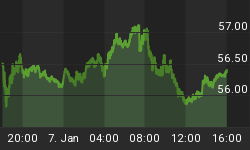Below is an excerpt from a commentary originally posted at www.speculative-investor.com on 30th August 2009.
In our 5th August commentary we explained that the central bank couldn't simply withdraw monetary stimulus in order to avoid an inflation problem, because injecting new money doesn't just alter the general price level; it also changes the STRUCTURE of the economy. In the world of economics there are few things of greater importance than the concept of how monetary inflation really works, and yet hardly anyone understands it. Of special relevance, the current Fed chairman appears to have absolutely no idea how monetary inflation affects the economy. We'll therefore take another shot at explaining it; this time, for the sake of clarity and brevity, in point form.
1. When the money supply is increased by, say, 10%, the result is NOT a 10% across-the-board increase in prices. This is because the new money is spent in specific areas and on specific projects, rather than spread evenly throughout the economy.
2. Resources get drawn to the areas where the new money is spent, but no NEW resources were conjured into existence along with the new money. Consequently, existing resources get sucked away from some parts of the economy towards the initial beneficiaries of the monetary injection. For example, let's assume that the government decides to spend a pile of new money on the construction of bridges. When it does so it bids away resources, including construction engineers and bridge-building materials, from other parts of the economy, which has the effect of increasing the operating costs of companies outside the bridge-building sector that also employ construction engineers and use similar materials. These companies will likely find themselves in financial difficulty due to the government's decision to direct resources towards bridge building, and some will go out of business. For another example, let's assume that ploughing new money into one segment of the economy causes the companies within that segment to consume more oil, leading to an increase in the oil price. This imposes an additional financial burden on all other oil consumers, curtailing some expansion plans and causing some businesses that would otherwise have been viable to go under.
3. The idea that the government can target the spending of newly-created money towards so-called "idle" resources is a fantasy, but even if it were true it wouldn't prevent monetary injections from changing the structure of the economy in an adverse and unsustainable way. This is because the act of spending the money that has been created out of nothing transfers existing purchasing power from the overall economy to the first recipients of the new money.
4. In summary, when the central bank or the private banks inject new money into the economy the net result is that some businesses are helped, some businesses are hurt, resources are transferred, wastage occurs due to the less-efficient use of resources and the government's take, and a new economic structure evolves based on monetary illusion.
5. The distortions and the wastage caused by monetary inflation will be REVEALED after the flow of new money is constricted. When that happens, many of the activities that sprang up on the back of the money-supply expansion will collapse and the economy will be forced to reallocate resources based on sustainable consumption trends (as opposed to the consumption trends prompted by the monetary illusion). On the other hand, if the flow of new money is not constricted (if, instead, the central bank chooses to perpetuate the monetary inflation) then the end result will be hyperinflation.
6. Analysis of the 1936-1939 period is instructive. Many people believe that the Fed erred by tapping on the monetary brake during 1936-1937, and that if policymakers had simply kept the money flowing then the US economy would have avoided the 1937-1939 collapse (the depression within a depression). However, the collapse of 1937-1939 was the INEVITABLE consequence of the fact that the preceding economic rebound had no real foundation. The rebound was based on monetary inflation and increased government spending, rather than on increased private investment in projects that made economic sense. It was therefore a foregone conclusion that any slowdown in monetary and/or fiscal stimulus would soon be followed by a collapse. The only question was when. If the stimulus had been maintained for an additional year or two then the ensuing collapse would have been even more devastating; and if policymakers had attempted to make the stimulus never-ending then the US dollar would have been destroyed.
7. Shortly after today's policymakers slow the pace at which the economy is being "stimulated" by new money and increased government spending, the economic rebound will unravel with startling speed. Alternatively, if policymakers attempt to maintain the stimulus indefinitely then they will create hyperinflation.
We aren't offering a free trial subscription at this time, but free samples of our work (excerpts from our regular commentaries) can be viewed at: http://www.speculative-investor.com/new/freesamples.html
















